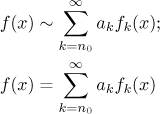
We start with an interesting result. First we state it in a classical form.
Theorem (Stone-Weierstrass theorem).
Let f be a function on a bounded closed interval I. If it is continuous, then for everyε > 0 there exists a polynomial P such that| f (x) − P(x)| < ε for every x from M.
That is, every continuous function can be approximated arbitrarily well by polynomials on bounded closed intervals. Now we will state it in a different language.
For every function f that is continuous on a bounded closed interval M there exists a sequence of polynomials{Pn} such thatPn ⇉ f on M.
While this theorem is very useful, it has one drawback. When we require better and better approximation, we usually need higher degree of Pn. However, the above theorem does not guarantee that a "longer" polynomial shares its beginning with a "shorter" polynomial, like it happens with the Taylor polynomial when we use a common center a and just change its degree. From this point of view the above theorem is not sufficient and we use the Taylor case as an inspiration for the following topic.
We are interested in Stone-Weierstrass approximations and Taylor polynomials for a simple reason. We would like to replace a given function that is perhaps not very pleasant by a function that we like without loosing too much. What does it mean, a "function that we like"? Usually we start with a set of nice and also simple functions, that is the basis for our work, and by "functions that we like" we mean all functions that can be obtained as linear combinations of that basic set. For instance, when approximating by polynomials, the basic system would be all powers xk and their linear combinations are exactly the polynomials. Now we will put this down more precisely.
Given a set M (for simplicity we will assume that it is an interval),
consider the set V of all functions defined on M. Then
V is a linear space. We will consider a sequence of functions
This brings us to the main object of interest. As we noted above, we prefer
the situation when improving the quality of approximation means adding extra
terms to an already existing approximation. This means that given a basic
system
What are these important questions? Given a linearly independent set of
functions
•
What functions f can be obtained as a sum of series
•
If
•
If
In concrete situations these questions are usually extremely difficult to answer, even for nice systems. Very often we proceed as follows:
When working with these basic systems of functions, we therefore often see the following notation.

The first line means that we took f and created the coefficients
ak according to a specific formula that we found in
the "wrong implication". Therefore this notation does not guarantee that the
sum of the resulting series is in fact equal to f from which it came.
The second line means that f is equal to the sum of a certain series.
Note that if we did not prove a result on uniqueness, then this series need
not necessarily come from that specific formula.
In the subsequent sections we will explore two useful basic systems of
functions. First we look at the system given by xk
(power series and
Taylor series). This system is
used to approximate "nice" functions and it is probably the most widely
known system. The second system
(Fourier series) is based on
functions